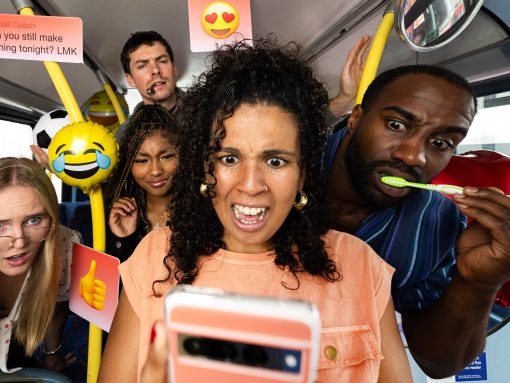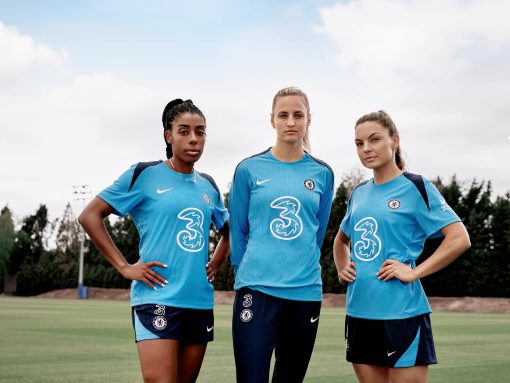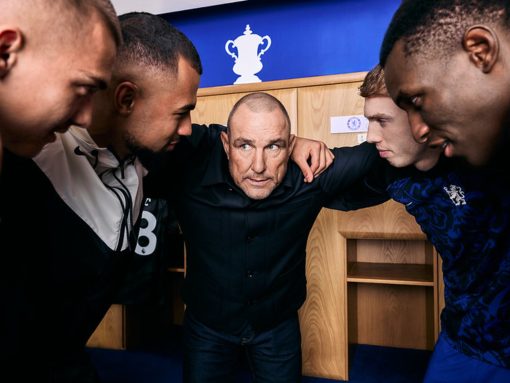#Epicfail? New study reveals we’re a nation that cares too much to criticise.
As the nation turns to niceness, the era of sharing pictures, videos and stories that poke fun at other’s misfortune – aka the ‘epic fail’ – is meeting its end. According to a new study [1] commissioned by mobile network Three, spreading happiness and showing those we care about that we’re thinking of them, are key moral motivations.
From pictures of gurgling babies to photo-bombing seals, people are now sharing tens of millions of self generated photos and internet memes on their mobiles instead.
The study was conducted by award-winning independent research agency, BrainJuicer, and collates an in depth analysis into the content people share and receive on their mobiles. The study analyses data from 2000 survey respondents, 200 week-long mobile diaries and expert interviews.
‘Schadenfreude’ (enjoyment of other people’s misfortune) or ‘epic fail’ was found to prompt negative or neutral emotions by 69 per cent of recipients and mirrors the decline in people using the search term ‘epic fail’[2] since the start of 2012. Despite being a nation that thrives on celebrity gossip, when it comes to sharing celeb-driven news and pictures, it accounted for just 2 per cent of shared content and prompted a feeling of contempt in nearly half (44%) of respondents.
The single biggest motivator to share is to make people smile (45%) and three out of four pieces of content (75%) is shared to make recipients feel happiness or to surprise them. In a show of selfless sharing, 45 per cent of us share to make the recipient feel happy, whereas only a third (31%) of people share because it makes them feel happy, revealing that giving happiness is more important than receiving it. A further 68 per cent agree that sharing provides a sense of belonging to a community.
“It’s really rewarding to stumble upon something online that you know a friend will enjoy and share it with them, whether it’s a cute picture of a cat, the latest Harlem Shake video or the downright daft stuff that we simply love. Additionally with increasing smartphone ownership people are creating their own content and sharing personal experiences instantly with their friends and family,” said Oliver Topley, Head of Insights at Three.
By far the most shared type of mobile content is personal photos. A huge 20.6 million are shared each week, followed in second place by cute pictures of animals which account for 7.2 million photos shared (34% of which are self-generated e.g. pet photos). From holiday happy snaps, ‘selfies’ (self portraits) and foodie photos to Lolcats and viral videos, only a mere 3 per cent of the mobile diary respondents weren’t actively sharing or receiving.
Dr Alain Samson, a psychologist associated with the London School of Economics and ECSP Europe[3] commented, “The findings seem to reflect the fact that mobile devices fulfil a more in-the-moment kind of communication function, allowing people to share experiences as they happen.
“Past studies have identified more self-serving motives as one factor behind the sharing of online content: passing on interesting, entertaining and funny content reflects positively on the sender. But sharing personal content implies a more intrinsic motivation with greater emphasis on nurturing relationships and generating reciprocity.”
Mark Earls, author of ‘Herd’, co-author of ‘I’ll Have What She’s Having’, and an expert on social influence and interactionsaid of the study, “Most of the sharing people do is with people they know. And it’s not about the thing they’re sharing, it’s about the relationship. Anthropologists call this “phatic” communication. The important thing in phatic communication isn’t the information that is being transmitted. It’s just a way of saying ‘I’m here, are you there? Are you ok?’ It’s a way of keeping the channels open between people.
“A generation ago people did it with mix tapes – the individual songs weren’t the important thing, it was the meaning that this gesture created in the relationship between sender and receiver. And it looks like now we do it with sharing content on mobiles.”
While most sharing intentions are kind, there is a devilish divide for some. Almost one in four (23%) share with the intent to provoke and nearly one in five (18%) share to draw attention to themselves. One respondent quipped, “Sent a picture of a super-scrimpers poster to my partner because she’s so stingy!”, another wanting to make a friend jealous, “Because they had less snow in their garden!”, while another sent a humorous wisdom tooth meme to poke fun at their boyfriend’s wisdom tooth that was “Growing weird”.
“Sharing silly stuff to make people smile is something that smartphones and our Ultrafast network is at the forefront of facilitating,” continued OIiver Topley from Three. “On average our customers are using 1.3GB data per month3 which suggests that using your smartphone to share content and be connected really matters.”
| Shared content in an average week by type of content shared | |
| Personal photos | 20.6 million |
| Animal photos | 7.2 million |
| Offers and promotions | 7 million |
| Viral/funny pictures | 4.8 million |
| News stories | 3.8 million |
| Jokes | 2.9 million |
| Viral/funny videos | 2.6 million |
| Music | 2.1 million |
| Other | 15.8 million |
The full report on mobile social sharing, including detail on the study’s methodology, can be downloaded here.
[1] Study by BrainJuicer in January/February 2013
[2] Google trends analysis
[3] ESCP Europe was established in 1819, it is the World’s First Business School
3 Three Network Intelligence data, average usage per contract customer Sept – Dec 2012
Notes to Editors
Contact information.
| Name | Three Consumer PR Team |
| Phone | 020 7234 9150 |
| three@cowpr.com |
Follow @ThreeUK on Twitter for the latest product announcements.
About Three
Three is a communications company. We are focused on challenging the industry to make mobile better for everyone.
We want to give customers a quality mobile experience and address the industry issues that frustrate them.
We were the first UK network to introduce all-you-can-eat data and offer 4G at no extra cost. We let customers roam abroad with their domestic bundle for no extra charge and do not charge for calling 0800 numbers.
We continue to look at ways of improving the experience we offer our customers.
Three carries over 45% of the UK’s mobile data. Our 3G network covers 98% of the UK population.
We launched 4G in 2014 and plan to have 50 cities and 200 towns covered by 4G by December 2014. By the end of 2015 98% of the population will be able to access 4G through a combination of new sites and deploying new spectrum.
Three is a member of the HWL group of companies, with investments in mobile operations in Australia, Austria, Denmark, Hong Kong, Indonesia, Ireland, Italy, Macau, Sri Lanka, Sweden and Vietnam.
Three employs over 4,400 people across its offices in Maidenhead, Glasgow and Reading and its 345 retail stores.
For more information visit www.three.co.uk.
BrainJuicer is an independent market research agency with headquarters in London and a total of 14 offices in 11 countries worldwide. Founded in 1999 by “Chief Juicer” John Kearon, BrainJuicer specialises in translating a generation of breakthroughs in psychology, behavioural economics and social sciences into Juicy tools that better understand and predict people’s behaviour. BrainJuicer has won multiple awards for its tools and research, most recently a Best Paper award from the industry’s ESOMAR Congress for “Research in a World Without Questions” exploring how researchers can use new tools to uncover insights without asking direct questions.


